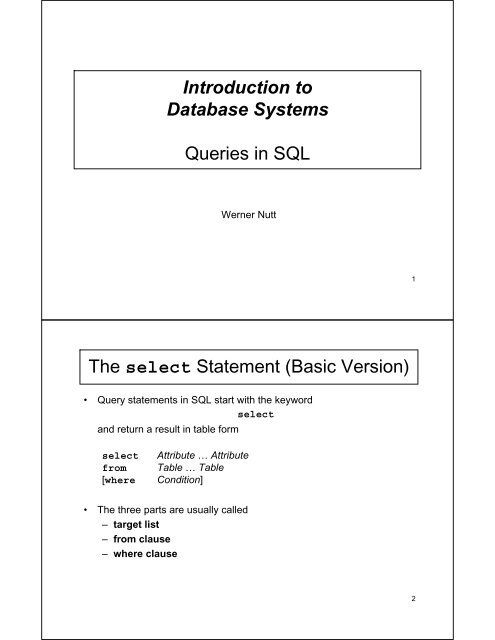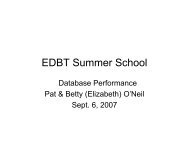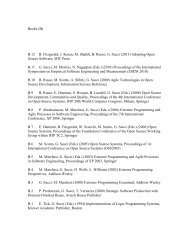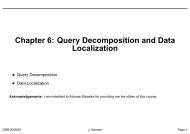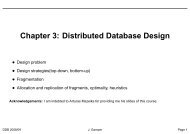Introduction to Database Systems Queries in SQL The select ...
Introduction to Database Systems Queries in SQL The select ...
Introduction to Database Systems Queries in SQL The select ...
Create successful ePaper yourself
Turn your PDF publications into a flip-book with our unique Google optimized e-Paper software.
<strong>Introduction</strong> <strong>to</strong><br />
<strong>Database</strong> <strong>Systems</strong><br />
<strong>Queries</strong> <strong>in</strong> <strong>SQL</strong><br />
Werner Nutt<br />
1<br />
<strong>The</strong> <strong>select</strong> Statement (Basic Version)<br />
• Query statements <strong>in</strong> <strong>SQL</strong> start with the keyword<br />
<strong>select</strong><br />
and return a result <strong>in</strong> table form<br />
<strong>select</strong><br />
from<br />
[where<br />
Attribute … Attribute<br />
Table … Table<br />
Condition]<br />
• <strong>The</strong> three parts are usually called<br />
– target list<br />
– from clause<br />
– where clause<br />
2
MotherChild<br />
mother child<br />
Lisa Mary<br />
Lisa Greg<br />
Anne Kim<br />
Anne Phil<br />
Mary Andy<br />
Mary Rob<br />
FatherChild<br />
father child<br />
Steve Frank<br />
Greg Kim<br />
Greg Phil<br />
Frank Andy<br />
Frank Rob<br />
Person<br />
name age<br />
Andy 27<br />
Rob 25<br />
Mary 55<br />
Anne 50<br />
Phil 26<br />
Greg 50<br />
Frank 60<br />
Kim 30<br />
Mike 85<br />
Lisa 75<br />
<strong>in</strong>come<br />
21<br />
15<br />
42<br />
35<br />
30<br />
40<br />
20<br />
41<br />
35<br />
87<br />
3<br />
Selection and Projection<br />
Name and <strong>in</strong>come of persons that are less than 30:<br />
π name, <strong>in</strong>come (σ age
Nam<strong>in</strong>g Conventions<br />
• To avoid ambiguities, every attribute name has two components<br />
RelationName.AttributeName<br />
• When there is no ambiguity, one can drop the <strong>in</strong>itial component<br />
RelationName.<br />
<strong>select</strong> person.name, person.<strong>in</strong>come<br />
from person<br />
where person.age < 30<br />
can be written as:<br />
<strong>select</strong> name, <strong>in</strong>come<br />
from person<br />
where age < 30<br />
5<br />
<strong>select</strong>: Abbreviations<br />
<strong>select</strong> name, <strong>in</strong>come<br />
from person<br />
where age < 30<br />
is an abbreviation for:<br />
<strong>select</strong> person.name, person.<strong>in</strong>come<br />
from person<br />
where person.age < 30<br />
and also for:<br />
<strong>select</strong> p.name as name, p.<strong>in</strong>come as <strong>in</strong>come<br />
from person p<br />
where p.age < 30<br />
6
Two K<strong>in</strong>ds of Projection<br />
Surname and branch of all employees<br />
Employee<br />
empNo surname branch salary<br />
7309 Black York 55<br />
5998 Black Glasgow 64<br />
9553 Brown London 44<br />
5698 Brown London 64<br />
π surname, branch (Employee)<br />
7<br />
Two K<strong>in</strong>ds of Projection<br />
<strong>select</strong><br />
surname, branch<br />
from employee<br />
<strong>select</strong> dist<strong>in</strong>ct<br />
surname, branch<br />
from employee<br />
surname<br />
Black<br />
Black<br />
Brown<br />
Brown<br />
branch<br />
York<br />
Glasgow<br />
London<br />
London<br />
surname<br />
Black<br />
Black<br />
Brown<br />
ranch<br />
York<br />
Glasgow<br />
London<br />
8
Usage of “as” <strong>in</strong> <strong>select</strong> Statements<br />
“as” <strong>in</strong> the list of attributes specifies explicitly a name for the<br />
attributes of the result. If for some attribute “as” is miss<strong>in</strong>g, the<br />
name is equal <strong>to</strong> the one that appears <strong>in</strong> the list.<br />
Example:<br />
<strong>select</strong> name as personName, <strong>in</strong>come as salary<br />
from person<br />
where age < 30<br />
returns as result a relation with two attributes, the first hav<strong>in</strong>g the<br />
name personName and the second hav<strong>in</strong>g the name salary<br />
<strong>select</strong> name, <strong>in</strong>come<br />
from person<br />
where age < 30<br />
returns as result a relation with two attributes, the first hav<strong>in</strong>g the<br />
name name and the second hav<strong>in</strong>g the name <strong>in</strong>come<br />
9<br />
Exercise 1<br />
“From the table person, compute a new table by<br />
<strong>select</strong><strong>in</strong>g only the persons with an <strong>in</strong>come between 20<br />
and 30, and add<strong>in</strong>g an attribute that has, for every tuple,<br />
the same value as <strong>in</strong>come.<br />
Show the result of the query”<br />
Person<br />
name age<br />
<strong>in</strong>come<br />
10
Exercise 1: Solution<br />
<strong>select</strong> name, age, <strong>in</strong>come,<br />
<strong>in</strong>come as also-<strong>in</strong>come<br />
from person<br />
where <strong>in</strong>come >= 20 and <strong>in</strong>come
<strong>select</strong> with Asterisk<br />
Given a relation R with attributes A, B, C<br />
<strong>select</strong> *<br />
from R<br />
where cond<br />
is equivalent <strong>to</strong><br />
<strong>select</strong> A, B, C<br />
from R<br />
where cond<br />
13<br />
Projection without Selection<br />
name and <strong>in</strong>come of all persons<br />
π name, <strong>in</strong>come (Person)<br />
<strong>select</strong> name, <strong>in</strong>come<br />
from person<br />
is an abbreviation for:<br />
<strong>select</strong> p.name, p.<strong>in</strong>come<br />
from person p<br />
where true<br />
14
Expressions <strong>in</strong> the Target List<br />
<strong>select</strong> <strong>in</strong>come/4 as quarterlyIncome<br />
from person<br />
where name = ‘Greg'<br />
Complex Conditions <strong>in</strong> the “where” Clause<br />
<strong>select</strong> *<br />
from person<br />
where <strong>in</strong>come > 25<br />
and (age < 30 or age > 60)<br />
15<br />
<strong>The</strong> “like” Condition<br />
<strong>The</strong> persons hav<strong>in</strong>g a name that starts with 'A' and has a 'd' as the third<br />
letter:<br />
<strong>select</strong> *<br />
from person<br />
where name like 'A_d%‘<br />
• ‘_‘ matches a s<strong>in</strong>gle letter<br />
• ‘%‘ matches a str<strong>in</strong>g<br />
16
Handl<strong>in</strong>g of Null Values<br />
Employees whose age is or could be greater than 40:<br />
σ age > 40 OR age IS NULL (Employee)<br />
<strong>select</strong> *<br />
from employee<br />
where age > 40 or age is null<br />
17<br />
Exercise 2<br />
“From the table employee, calculate a new table by<br />
<strong>select</strong><strong>in</strong>g only employees from the London and Glasgow<br />
branches, project<strong>in</strong>g the data on the attribute salary,<br />
and add<strong>in</strong>g an attribute that has, for every tuple, twice the<br />
value of the attribute salary.<br />
Show the result of the query”<br />
Employee<br />
empNo<br />
surname branch salary<br />
18
Exercise 2: Solution<br />
<strong>select</strong> salary,<br />
salary*2 as doubleSalary<br />
from employee<br />
where branch = ‘Glasgow' or<br />
branch = ‘London'<br />
salary<br />
64<br />
44<br />
64<br />
doubleSalary<br />
128<br />
88<br />
128<br />
19<br />
Selection, Projection, and Jo<strong>in</strong><br />
• Us<strong>in</strong>g <strong>select</strong> statements with a s<strong>in</strong>gle relation <strong>in</strong> the<br />
from clause we can realise:<br />
– <strong>select</strong>ions,<br />
– projections,<br />
– renam<strong>in</strong>gs<br />
• Jo<strong>in</strong>s (and Cartesian products) are realised by us<strong>in</strong>g two<br />
or more relations <strong>in</strong> the from clause<br />
20
<strong>SQL</strong> and Relational Algebra<br />
Given the relations: R1(A1,A2) and R2(A3,A4)<br />
the semantics of the query<br />
<strong>select</strong> R1.A1, R2.A4<br />
from R1, R2<br />
where R1.A2 = R2.A3<br />
can be described <strong>in</strong> terms of<br />
• Cartesian product (from)<br />
• <strong>select</strong>ion (where)<br />
• projection (<strong>select</strong>)<br />
Note: This does not mean that the system really<br />
calculates the Cartesian product!<br />
21<br />
<strong>SQL</strong> and Relational Algebra (cntd)<br />
Given the relations: R1(A1,A2) and R2(A3,A4),<br />
<strong>select</strong> R1.A1, R2.A4<br />
from R1, R2<br />
where R1.A2 = R2.A3<br />
corresponds <strong>to</strong>:<br />
π A1,A4 (σ A2=A3 (R1 x R2))<br />
22
<strong>SQL</strong> and Relational Algebra (cntd)<br />
It may be necessary <strong>to</strong> rename attributes<br />
• <strong>in</strong> the target list (as <strong>in</strong> relational algebra)<br />
• <strong>in</strong> the Cartesian product (<strong>in</strong> particular, when the query refers<br />
twice <strong>to</strong> the same table)<br />
<strong>select</strong> X.A1 as B1, ...<br />
from R1 X, R2 Y, R1 Z<br />
where X.A2 = Y.A3 and ...<br />
which can also be written as<br />
<strong>select</strong> X.A1 as B1, ...<br />
from R1 as X, R2 as Y, R1 as Z<br />
where X.A2 = Y.A3 and ...<br />
23<br />
<strong>SQL</strong> and Relational Algebra (cntd)<br />
<strong>select</strong> X.A1 as B1, Y.A4 as B2<br />
from R1 X, R2 Y, R1 Z<br />
where X.A2 = Y.A3 and Y.A4 = Z.A1<br />
X ← R1, Y ← R2, Z ← R1,<br />
ρ B1←X.A1, B2←Y.A4 (<br />
π X.A1,Y.A4 (σ X.A2 = Y.A3 and Y.A4 = Z.A1 (X x Y x Z)))<br />
24
MotherChild<br />
mother child<br />
Lisa Mary<br />
Lisa Greg<br />
Anne Kim<br />
Anne Phil<br />
Mary Andy<br />
Mary Rob<br />
FatherChild<br />
father child<br />
Steve Frank<br />
Greg Kim<br />
Greg Phil<br />
Frank Andy<br />
Frank Rob<br />
Person<br />
name age<br />
Andy 27<br />
Rob 25<br />
Mary 55<br />
Anne 50<br />
Phil 26<br />
Greg 50<br />
Frank 60<br />
Kim 30<br />
Mike 85<br />
Lisa 75<br />
<strong>in</strong>come<br />
21<br />
15<br />
42<br />
35<br />
30<br />
40<br />
20<br />
41<br />
35<br />
87<br />
25<br />
Exercise 3<br />
“<strong>The</strong> fathers of persons who earn more than 20K”<br />
Write the query both <strong>in</strong> relational algebra and <strong>SQL</strong><br />
26
Exercise 3: Solution<br />
“<strong>The</strong> fathers of persons who earn more than 20K”<br />
π father (FatherChild<br />
child=name σ <strong>in</strong>come>20 (Person))<br />
<strong>select</strong> dist<strong>in</strong>ct fc.father<br />
from person p, fatherChild fc<br />
where fc.child = p.name<br />
and p.<strong>in</strong>come > 20<br />
27<br />
Exercise 4: Jo<strong>in</strong><br />
“Father and mother of every person”<br />
Write the query both <strong>in</strong> relational algebra and <strong>SQL</strong><br />
28
Exercise 4: Solution<br />
“Father and mother of every person”<br />
Can be calculated <strong>in</strong> relational algebra by means of a<br />
natural jo<strong>in</strong><br />
FatherChild<br />
MotherChild<br />
<strong>select</strong> fc.child, fc.father, mc.mother<br />
from motherChild mc, fatherChild fc<br />
where fc.child = mc.child<br />
29<br />
Exercise 4: Jo<strong>in</strong> and Other Operations<br />
“Persons that earn more than their father,<br />
show<strong>in</strong>g name, <strong>in</strong>come, and <strong>in</strong>come of the father”<br />
Write the query both <strong>in</strong> relational algebra and <strong>SQL</strong><br />
30
Exercise 5: Solution<br />
“Persons that earn more than their father,<br />
show<strong>in</strong>g name, <strong>in</strong>come, and <strong>in</strong>come of the father”<br />
π name, <strong>in</strong>come, IF (σ <strong>in</strong>come>IF<br />
(ρ FN name, FA age, FI <strong>in</strong>come (Person)<br />
FN=father<br />
(FatherChild<br />
child =name Person)))<br />
<strong>select</strong> f.name, f.<strong>in</strong>come, c.<strong>in</strong>come<br />
from person f, fatherChild fc, person c<br />
where f.name = fc.father and<br />
fc.child = c.name and<br />
c.<strong>in</strong>come > f.<strong>in</strong>come<br />
31<br />
<strong>select</strong>, with Renam<strong>in</strong>g of the Result<br />
For the persons that earn more than their father, show their<br />
name, <strong>in</strong>come, and the <strong>in</strong>come of the father<br />
<strong>select</strong> fc.child, c.<strong>in</strong>come as <strong>in</strong>come,<br />
f.<strong>in</strong>come as <strong>in</strong>comefather<br />
from person f, fatherChild fc, person c<br />
where f.name = fc.father and<br />
fc.child = c.name and<br />
c.<strong>in</strong>come > f.<strong>in</strong>come<br />
32
Explicit Jo<strong>in</strong><br />
For every person, return the person, their father and their<br />
mother<br />
<strong>select</strong> fatherChild.child, father, mother<br />
from motherChild, fatherChild<br />
where fatherChild.child = motherChild.child<br />
<strong>select</strong> fatherChild.child, father, mother<br />
from motherChild jo<strong>in</strong> fatherChild on<br />
fatherChild.child = motherChild.child<br />
33<br />
<strong>select</strong> with Explicit Jo<strong>in</strong>, Syntax<br />
<strong>select</strong> …<br />
from Table { jo<strong>in</strong> Table on Jo<strong>in</strong>Condition }, …<br />
[ where OtherCondition ]<br />
34
Exercise 6: Explicit Jo<strong>in</strong><br />
“For the persons that earn more than their father, show their<br />
name, <strong>in</strong>come, and the <strong>in</strong>come of the father”<br />
Express the query <strong>in</strong> <strong>SQL</strong>, us<strong>in</strong>g an explicit jo<strong>in</strong><br />
35<br />
Exercise 6: Solution<br />
“For the persons that earn more than their father, show their<br />
name, <strong>in</strong>come, and the <strong>in</strong>come of the father”<br />
<strong>select</strong> c.name, c.<strong>in</strong>come, f.<strong>in</strong>come<br />
from person c<br />
jo<strong>in</strong> fatherChild fc on c.name = fc.child<br />
jo<strong>in</strong> person f on fc.father = f.name<br />
where c.<strong>in</strong>come > f.<strong>in</strong>come<br />
An equivalent formulation without explicit jo<strong>in</strong>:<br />
<strong>select</strong> c.name, c.<strong>in</strong>come, f.<strong>in</strong>come<br />
from person c, fatherChild fc, person f<br />
where c.name = fc.child and<br />
fc.father = f.name and<br />
c.<strong>in</strong>come > f.<strong>in</strong>come<br />
36
A Further Extension: Natural Jo<strong>in</strong><br />
(Less Frequent)<br />
“Return the names of fathers, mothers, and their children”<br />
π father,mother,child (FatherChild<br />
MotherChild)<br />
In <strong>SQL</strong>:<br />
<strong>select</strong> father, mother, fatherChild.child<br />
from motherChild jo<strong>in</strong> fatherChild on<br />
fatherChild.child = motherChild.child<br />
Alternatively:<br />
<strong>select</strong> father, mother, fatherChild.child<br />
from motherChild natural jo<strong>in</strong> fatherChild<br />
37<br />
Outer Jo<strong>in</strong><br />
“For every person, return the father and, if known, the mother”<br />
<strong>select</strong> fatherChild.child, father, mother<br />
from fatherChild left outer jo<strong>in</strong> motherChild<br />
on fatherChild.child = motherChild.child<br />
Note: “outer” is optional<br />
<strong>select</strong> fatherChild.child, father, mother<br />
from fatherChild left jo<strong>in</strong> motherChild<br />
on fatherChild.child = motherChild.child<br />
38
Outer Jo<strong>in</strong>: Examples<br />
<strong>select</strong> fatherChild.child, father, mother<br />
from motherChild jo<strong>in</strong> fatherChild<br />
on motherChild.child = fatherChild.child<br />
<strong>select</strong> fatherChild.child, father, mother<br />
from motherChild left outer jo<strong>in</strong> fatherChild<br />
on motherChild.child = fatherChild.child<br />
<strong>select</strong> fatherChild.child, father, mother<br />
from motherChild right outer jo<strong>in</strong> fatherChild<br />
on motherChild.child = fatherChild.child<br />
<strong>select</strong> fatherChild.child, father, mother<br />
from motherChild full outer jo<strong>in</strong> fatherChild<br />
on motherChild.child = fatherChild.child<br />
39<br />
Order<strong>in</strong>g the Result: order by<br />
“Return name and <strong>in</strong>come of persons under thirty, <strong>in</strong><br />
alphabetic order of the names”<br />
<strong>select</strong> name, <strong>in</strong>come<br />
from person<br />
where age < 30<br />
order by name<br />
<strong>select</strong> name, <strong>in</strong>come<br />
from person<br />
where age < 30<br />
order by name desc<br />
ascend<strong>in</strong>g<br />
order<br />
descend<strong>in</strong>g<br />
order<br />
40
Order<strong>in</strong>g the Result: order by<br />
<strong>select</strong> name, <strong>in</strong>come<br />
from person<br />
where age < 30<br />
<strong>select</strong> name, <strong>in</strong>come<br />
from person<br />
where age < 30<br />
order by name<br />
name <strong>in</strong>come<br />
Andy 21<br />
Rob 15<br />
Mary 42<br />
name <strong>in</strong>come<br />
Andy 21<br />
Mary 42<br />
Rob 15<br />
41<br />
Aggregate Opera<strong>to</strong>rs<br />
Among the expressions <strong>in</strong> the target list, we can also have<br />
expressions that calculate values based on multisets of<br />
tuples:<br />
– count, m<strong>in</strong>imum, maximum, average, sum<br />
Basic Syntax (simplified):<br />
Function ( [ dist<strong>in</strong>ct ] ExpressionOnAttributes )<br />
42
Aggregate Opera<strong>to</strong>rs: count<br />
Syntax:<br />
• counts the number of tuples:<br />
count (*)<br />
• counts the values of an attribute (consider<strong>in</strong>g duplicates):<br />
count (Attribute)<br />
• counts the dist<strong>in</strong>ct values of an attribute:<br />
count (dist<strong>in</strong>ct Attribute)<br />
43<br />
Aggregate Opera<strong>to</strong>r count: Example<br />
Example: How many children has Frank?<br />
<strong>select</strong> count(*) as NumFranksChildren<br />
from fatherChild<br />
where father = 'Frank'<br />
Semantics: <strong>The</strong> aggregate opera<strong>to</strong>r (count), which counts the tuples, is<br />
applied <strong>to</strong> the result of the query:<br />
<strong>select</strong> *<br />
from fatherChild<br />
where father = 'Frank'<br />
44
Results of count: Example<br />
FatherChild<br />
father<br />
Steve<br />
Greg<br />
Greg<br />
Frank<br />
Frank<br />
child<br />
Frank<br />
Kim<br />
Phil<br />
Andy<br />
Rob<br />
NumFranksChildren<br />
2<br />
45<br />
<strong>select</strong> count(*)<br />
from person<br />
<strong>select</strong> count(<strong>in</strong>come)<br />
from person<br />
count and Null Values<br />
<strong>select</strong> count(dist<strong>in</strong>ct <strong>in</strong>come)<br />
from person<br />
Person<br />
name age<br />
Andy 27<br />
Rob 25<br />
Mary 55<br />
Anne 50<br />
Result<br />
Result<br />
Result<br />
<strong>in</strong>come<br />
21<br />
NULL<br />
21<br />
35<br />
= number of tuples<br />
=4<br />
= number of values<br />
different from NULL<br />
=3<br />
= number of dist<strong>in</strong>ct<br />
values (exclud<strong>in</strong>g<br />
NULL)<br />
=2<br />
46
Other Aggregate Opera<strong>to</strong>rs<br />
sum, avg, max, m<strong>in</strong><br />
• argument can be an attribute or an expression<br />
(but not “*”)<br />
• sum and avg: numerical and temporal arguments<br />
• max and m<strong>in</strong>: arguments on which an order<strong>in</strong>g is def<strong>in</strong>ed<br />
Example: Average <strong>in</strong>come of Frank’s children<br />
<strong>select</strong> avg(p.<strong>in</strong>come)<br />
from person p jo<strong>in</strong> fatherChild fc on<br />
p.name = fc.child<br />
where fc.father = 'Frank'<br />
47<br />
Aggregate Opera<strong>to</strong>rs and Null Values<br />
<strong>select</strong> avg(<strong>in</strong>come) as meanIncome<br />
from person<br />
Person<br />
name age<br />
Andy 27<br />
Rob 25<br />
Mary 55<br />
Anne 50<br />
<strong>in</strong>come<br />
30<br />
NULL<br />
36<br />
36<br />
is<br />
ignored<br />
meanIncome<br />
34<br />
48
Aggregate Opera<strong>to</strong>rs and the Target List<br />
An <strong>in</strong>correct query (whose name should be returned?):<br />
<strong>select</strong> name, max(<strong>in</strong>come)<br />
from person<br />
<strong>The</strong> target list has <strong>to</strong> be homogeneous, for example:<br />
<strong>select</strong> m<strong>in</strong>(age), avg(<strong>in</strong>come)<br />
from person<br />
49<br />
Aggregate Opera<strong>to</strong>rs and Group<strong>in</strong>g<br />
• Aggregation functions can be applied <strong>to</strong> partitions of the<br />
tuples of a relations<br />
• To specify the partition of tuples, on uses the group by<br />
clause:<br />
group by attributeList<br />
50
Aggregate Opera<strong>to</strong>rs and Group<strong>in</strong>g<br />
<strong>The</strong> number of children of every father.<br />
<strong>select</strong> father, count(*) as NumChildren<br />
from fatherChild<br />
group by father<br />
FatherChild<br />
father<br />
Steve<br />
Greg<br />
Greg<br />
Frank<br />
Frank<br />
child<br />
Frank<br />
Kim<br />
Phil<br />
Andy<br />
Rob<br />
father NumChildren<br />
Steve<br />
Greg<br />
1<br />
2<br />
Frank 2<br />
51<br />
Semantics of <strong>Queries</strong> with Aggregation<br />
and Group<strong>in</strong>g<br />
1. <strong>The</strong> query is run ignor<strong>in</strong>g the group by clause and the<br />
aggregate opera<strong>to</strong>rs:<br />
<strong>select</strong> *<br />
from fatherChild<br />
2. <strong>The</strong> tuples that have the same value for the<br />
attributes appear<strong>in</strong>g <strong>in</strong> the group by clause, are<br />
grouped <strong>in</strong><strong>to</strong> equivalence classes.<br />
3. Each group contributes a tuple <strong>to</strong> the answer. <strong>The</strong><br />
tuple consists of the values of the group by attributes<br />
and the result of apply<strong>in</strong>g the aggregation function <strong>to</strong><br />
the group.<br />
52
Exercise 7: group by<br />
“For each group of adult persons who have the same age,<br />
return the maximum <strong>in</strong>come for every group and show the<br />
age”<br />
Write the query <strong>in</strong> <strong>SQL</strong>!<br />
Person<br />
name age<br />
<strong>in</strong>come<br />
53<br />
Exercise 7: Solution<br />
“For each group of adult persons who have the same age,<br />
return the maximum <strong>in</strong>come for every group and show the<br />
age”<br />
<strong>select</strong> age, max(<strong>in</strong>come)<br />
from person<br />
where age > 17<br />
group by age<br />
54
Group<strong>in</strong>g and Target List<br />
In a query that has a group by clause, only such attributes can appear<br />
<strong>in</strong> the target list (except for aggregation functions) the appear <strong>in</strong> the<br />
group by clause.<br />
Example: Incorrect: <strong>in</strong>come of persons, grouped accord<strong>in</strong>g <strong>to</strong> age<br />
<strong>select</strong> age, <strong>in</strong>come<br />
from person<br />
group by age<br />
<strong>The</strong>re could exist several values for the same group.<br />
Correct: average <strong>in</strong>come of persons, grouped by age.<br />
<strong>select</strong> age, avg(<strong>in</strong>come)<br />
from person<br />
group by age<br />
55<br />
Group<strong>in</strong>g and Target List (cntd)<br />
<strong>The</strong> syntactic restriction on the attributes <strong>in</strong> the <strong>select</strong> clause holds also for<br />
queries that would be semantically correct (i.e., for which there is only a<br />
s<strong>in</strong>gle value of the attribute for every group).<br />
Example: Fathers with their <strong>in</strong>come and with the average <strong>in</strong>come of their<br />
children.<br />
Incorrect:<br />
<strong>select</strong> fc.father, avg(c.<strong>in</strong>come), f.<strong>in</strong>come<br />
from person c jo<strong>in</strong> fatherChild fc on c.name=fc.child<br />
jo<strong>in</strong> person f on fc.father=f.name<br />
group by fc.father<br />
Correct:<br />
<strong>select</strong> fc.ather, avg(c.<strong>in</strong>come), f.<strong>in</strong>come<br />
from person c jo<strong>in</strong> fatherChild fc on c.name=fc.child<br />
jo<strong>in</strong> person f on fc.father=f.name<br />
group by fc.father, f.<strong>in</strong>come<br />
56
Conditions on Groups<br />
It is also possible <strong>to</strong> filter the groups us<strong>in</strong>g <strong>select</strong>ion conditions.<br />
Clearly, the <strong>select</strong>ion of groups differs from the <strong>select</strong>ion of the tuples <strong>in</strong><br />
the where clause: the tuples form the groups.<br />
To filter the groups, the “hav<strong>in</strong>g clause” is used.<br />
<strong>The</strong> hav<strong>in</strong>g clause must appear after the “group by”<br />
Example: “Fathers whose children have an average <strong>in</strong>come greater 25.”<br />
<strong>select</strong> fc.father, avg(c.<strong>in</strong>come)<br />
from person c jo<strong>in</strong> fatherChild fc<br />
on c.name = fc.child<br />
group by fc.father<br />
hav<strong>in</strong>g avg(c.<strong>in</strong>come) > 25<br />
57<br />
Exercise 8: where or hav<strong>in</strong>g?<br />
“Fathers whose children under age 30 have an average<br />
<strong>in</strong>come greater 20”<br />
58
Exercise 8: Solution<br />
“Fathers whose children under the age of 30 have an<br />
average <strong>in</strong>come greater 20”<br />
<strong>select</strong> father, avg(f.<strong>in</strong>come)<br />
from<br />
person c jo<strong>in</strong> fatherChild fc<br />
on c.name = fc.child<br />
where c.age < 30<br />
group by cf.father<br />
hav<strong>in</strong>g avg(c.<strong>in</strong>come) > 20<br />
59<br />
Syntax of <strong>SQL</strong> <strong>select</strong> (Summary)<br />
<strong>SQL</strong>Select ::=<br />
<strong>select</strong> ListOfAttributesOrExpressions<br />
from ListOfTables<br />
[ where ConditionsOnTuples ]<br />
[ group by ListOfGroup<strong>in</strong>gAttributes ]<br />
[ hav<strong>in</strong>g ConditionsOnAggregates ]<br />
[ order by ListOfOrder<strong>in</strong>gAttributes ]<br />
60
Union, Intersection, and Difference<br />
With<strong>in</strong> a <strong>select</strong> statement one cannot express unions.<br />
An explicit construct is needed:<br />
<strong>select</strong> ...<br />
union [all]<br />
<strong>select</strong> ...<br />
WIth union, duplicates are elim<strong>in</strong>ated (also those orig<strong>in</strong>at<strong>in</strong>g<br />
from projection).<br />
WIth union all duplicates are kept.<br />
61<br />
Positional Notation of Attributes<br />
<strong>select</strong> father, child<br />
from fatherChild<br />
union<br />
<strong>select</strong> mother, child<br />
from motherChild<br />
Which are the attribute names of the result?<br />
Those of the first operand!<br />
→<br />
→<br />
<strong>SQL</strong> matches attributes <strong>in</strong> the same position<br />
<strong>SQL</strong> renames the attributes of the second<br />
operand<br />
62
Result of the Union<br />
father<br />
Greg<br />
Greg<br />
Greg<br />
Frank<br />
Frank<br />
Lisa<br />
Lisa<br />
Anne<br />
Anne<br />
Mary<br />
Mary<br />
child<br />
Frank<br />
Kim<br />
Phil<br />
Andy<br />
Rob<br />
Mary<br />
Greg<br />
Kim<br />
Phil<br />
Andy<br />
Rob<br />
63<br />
Positional Notation: Example<br />
<strong>select</strong> father, child<br />
from fatherChild<br />
union<br />
<strong>select</strong> mother, child<br />
from motherChild<br />
<strong>select</strong> father, child<br />
from fatherChild<br />
union<br />
<strong>select</strong> child, mother<br />
from motherChild<br />
64
Positional Notation (cntd)<br />
Renam<strong>in</strong>g does not change anyth<strong>in</strong>g:<br />
<strong>select</strong> father as parent, child<br />
from fatherChild<br />
union<br />
<strong>select</strong> child, mother as parent<br />
from motherChild<br />
Correct (if we want <strong>to</strong> treat fathers and mothers as parents):<br />
<strong>select</strong> father as parent, child<br />
from fatherChild<br />
union<br />
<strong>select</strong> mother as parent, child<br />
from motherChild<br />
65<br />
Difference<br />
<strong>select</strong> name<br />
from employee<br />
except<br />
<strong>select</strong> lastName as name<br />
from employee<br />
We will see that differences can also be expressed with<br />
nested <strong>select</strong> statements.<br />
66
Intersection<br />
<strong>select</strong> name<br />
from employee<br />
<strong>in</strong>tersect<br />
<strong>select</strong> lastName as name<br />
from employee<br />
is equivalent <strong>to</strong><br />
<strong>select</strong> en.name<br />
from employee en, employee eln<br />
where en.name = eln.lastName<br />
67<br />
S<strong>in</strong>gle Block <strong>Queries</strong>: Exercises<br />
Consider a database about suppliers and parts with the follow<strong>in</strong>g schema:<br />
Supplier(sid, sname, address)<br />
Part(pid, pname, colour)<br />
Catalog(sid, pid, cost)<br />
Formulate the follow<strong>in</strong>g queries <strong>in</strong> <strong>SQL</strong>:<br />
1. F<strong>in</strong>d the names of suppliers who supply some red part.<br />
2. F<strong>in</strong>d the IDs of suppliers who supply some red or green part.<br />
3. F<strong>in</strong>d the IDs of suppliers who supply some red part and are based at 21<br />
George Street.<br />
68
S<strong>in</strong>gle Block <strong>Queries</strong>: Exercises (cntd)<br />
4. F<strong>in</strong>d the names of suppliers who supply some red part or are based<br />
at 21 George Street.<br />
5. F<strong>in</strong>d the IDs of suppliers who supply some red and some green part.<br />
6. F<strong>in</strong>d pairs of IDs such that for some part the supplier with the first ID<br />
charges more than the supplier with the second ID.<br />
7. For each supplier, return the maximal and the average cost of the<br />
parts they offer.<br />
8. List those red parts that on average cost no more than 30 Euro.<br />
9. List the names of those red parts that are offered by at least three<br />
suppliers.<br />
69<br />
Nested <strong>Queries</strong><br />
• In the a<strong>to</strong>mic conditions of the where clause one can also<br />
use a <strong>select</strong> clause (which must appear <strong>in</strong><br />
parentheses).<br />
• In particular, <strong>in</strong> a<strong>to</strong>mic conditions one can have:<br />
– comparisons of an attribute (or several attributes) with<br />
the result of a subquery<br />
– existential quantification<br />
70
Nested <strong>Queries</strong> (Example)<br />
“Name and <strong>in</strong>come of Frank’s father”<br />
<strong>select</strong><br />
from<br />
where<br />
f.name, f.<strong>in</strong>come<br />
person f, fatherChild fc<br />
f.name = fc.father and fc.child = 'Frank'<br />
<strong>select</strong><br />
from<br />
where<br />
f.name, f.<strong>in</strong>come<br />
person f<br />
f.name = (<strong>select</strong> fc.father<br />
from fatherChild fc<br />
where fc.child = 'Frank')<br />
71<br />
Nested <strong>Queries</strong>: Opera<strong>to</strong>rs<br />
In the where clause, the result of a nested query can be related <strong>to</strong><br />
other values by way of several opera<strong>to</strong>rs:<br />
• equality and other comparisons (the result of the nested query must<br />
be unique)<br />
• if it is not certa<strong>in</strong> that the result of the nested query is unique, the<br />
nested query can be preceded by one of the keywords:<br />
— any: true, if the comparison is true for at least one of the result<br />
tuples of the nested query<br />
— all: true, if the comparison is true for all the result tuples of the<br />
nested query<br />
• the opera<strong>to</strong>r <strong>in</strong>, which is equivalent <strong>to</strong> =any<br />
• the opera<strong>to</strong>r not <strong>in</strong>, which is equivalent <strong>to</strong> all<br />
• the opera<strong>to</strong>r exists<br />
72
Nested <strong>Queries</strong>: Example<br />
Name and <strong>in</strong>come of the fathers of persons who earn more than 20k.<br />
<strong>select</strong> dist<strong>in</strong>ct f.name, f.<strong>in</strong>come<br />
from person f, fatherChild fc, person c<br />
where f.name = fc.father and<br />
fc.child = c.name and c.<strong>in</strong>come > 20<br />
fathers of persons<br />
who earn more<br />
than 20k<br />
<strong>select</strong> f.name, f.<strong>in</strong>come<br />
from person f<br />
where f.name = any<br />
(<strong>select</strong> fc.father<br />
from fatherChild fc, person c<br />
where fc.child = c.name and<br />
c.<strong>in</strong>come > 20)<br />
73<br />
Nested <strong>Queries</strong>: Example<br />
Name and <strong>in</strong>come of the fathers of persons who earn more than 20k.<br />
<strong>select</strong> f.name, f.<strong>in</strong>come<br />
from person f<br />
where f.name <strong>in</strong> (<strong>select</strong> fc.father<br />
from fatherChild fc, person c<br />
where fc.child fathers of = c.name<br />
and persons c.<strong>in</strong>come who > 20)<br />
earn more than<br />
persons who<br />
20k<br />
earn more<br />
<strong>select</strong> f.name, f.<strong>in</strong>come<br />
than 20k<br />
from person f<br />
where f.name <strong>in</strong> (<strong>select</strong> fc.father<br />
from fatherChild fc<br />
where fc child <strong>in</strong> (<strong>select</strong> c.name<br />
from person c<br />
where c.<strong>in</strong>come > 20)<br />
)<br />
74
Nested <strong>Queries</strong>: Comments<br />
• <strong>The</strong> nested formulation of a query is usually executed<br />
less efficiently than an equivalent unnested formulation<br />
(due <strong>to</strong> limitations of the query optimizer).<br />
• <strong>The</strong> nested formulation is sometimes more readable.<br />
• <strong>The</strong> subqueries cannot conta<strong>in</strong> set opera<strong>to</strong>rs (“union is<br />
only performed at the <strong>to</strong>p level”), but this is not a<br />
significant limitation.<br />
75<br />
Nested <strong>Queries</strong>: Example with all<br />
“Persons who have an <strong>in</strong>come that is higher than the <strong>in</strong>come of all<br />
persons younger than 30”<br />
76
Nested <strong>Queries</strong>: Example with all<br />
“Persons who have an <strong>in</strong>come that is higher than the <strong>in</strong>come of all<br />
persons younger than 30”<br />
<strong>select</strong> name<br />
from person<br />
where <strong>in</strong>come >= all (<strong>select</strong> <strong>in</strong>come<br />
from person<br />
where age < 30)<br />
77<br />
Equivalent Formulation with max<br />
“Persons who have an <strong>in</strong>come that is higher than the <strong>in</strong>come of all<br />
persons younger than 30”<br />
<strong>select</strong> name<br />
from person<br />
where <strong>in</strong>come >= (<strong>select</strong> max(<strong>in</strong>come)<br />
from person<br />
where age < 30)<br />
78
Nested <strong>Queries</strong>: Example with exists<br />
An expression with the opera<strong>to</strong>r exists is true if the result of the<br />
subquery is not empty.<br />
Example: “Persons with at least one child”<br />
<strong>select</strong> *<br />
from person p<br />
where exists (<strong>select</strong> *<br />
from fatherChild fc<br />
where fc.father = p.name)<br />
or<br />
exists (<strong>select</strong> *<br />
from motherChild mc<br />
where mc.mother = p.name)<br />
Note: the attribute name refers <strong>to</strong> the table <strong>in</strong> the outer from clause.<br />
79<br />
Nest<strong>in</strong>g, Union, and “or”<br />
<strong>The</strong> query for “persons with at least one child” can also be expressed as<br />
a union:<br />
<strong>select</strong> p.name, p.age, p.<strong>in</strong>come<br />
from person p, fatherChild fc<br />
where fc.father = p.name<br />
union<br />
<strong>select</strong> p.name, p.age, p.<strong>in</strong>come<br />
from person p, motherChild mc<br />
where mc.mother = p.name<br />
Does the follow<strong>in</strong>g query with “or” return the same answers?<br />
<strong>select</strong> dist<strong>in</strong>ct p.name, p.age, p.<strong>in</strong>come<br />
from person p, fatherChild fc, motherChild mc<br />
where fc.father = p.name<br />
or mc.mother = p.name<br />
80
Nested <strong>Queries</strong> and Negation<br />
All the queries with nest<strong>in</strong>g <strong>in</strong> the previous examples are equivalent <strong>to</strong> some<br />
unnested query. So, what’s the po<strong>in</strong>t of nest<strong>in</strong>g?<br />
Example: “Persons without a child”<br />
<strong>select</strong> *<br />
from person p<br />
where not exists (<strong>select</strong> *<br />
from fatherChild fc<br />
where fc.father = p.name)<br />
and<br />
not exists (<strong>select</strong> *<br />
from motherChild mc<br />
where mc.mother = p.name)<br />
This cannot be expressed equivalently as a “<strong>select</strong> from where” query.<br />
Why?<br />
81<br />
Exercise 9<br />
“Name and age of the mothers all of whose children are at<br />
least 18”<br />
Approach 1: Subquery with all<br />
Approach 2: Subquery with m<strong>in</strong><br />
Approach 3: Subquery with not exists<br />
82
Exercise 9: Solution with all<br />
“Name and age of the mothers all of whose children are at<br />
least 18”<br />
<strong>select</strong> m.name, m.age<br />
from person m jo<strong>in</strong> motherChild mc<br />
on m.name = mc.mother<br />
where 18 =< all (<strong>select</strong> c0.age<br />
from motherChild mc0 jo<strong>in</strong> person c0<br />
on mc0.mother = c0.name<br />
where mc0.mother = mc.mother)<br />
83<br />
Exercise 9: Solution with m<strong>in</strong><br />
“Name and age of the mothers all of whose children are at<br />
least 18”<br />
<strong>select</strong> m.name, m.age<br />
from person m jo<strong>in</strong> motherChild mc<br />
on m.name = mc.mother<br />
where 18 =< (<strong>select</strong> m<strong>in</strong>(c0.age)<br />
from motherChild mc0 jo<strong>in</strong> person c0<br />
on mc0.mother = c0.name<br />
where mc0.mother = mc.mother)<br />
“Name and age of mothers where the m<strong>in</strong>imal age of their children is<br />
greater or equal 18”<br />
84
Exercise 9: Solution with not exists<br />
“Name and age of the mothers all of whose children are at<br />
least 18”<br />
<strong>select</strong> m.name, m.age<br />
from person m jo<strong>in</strong> motherChild mc<br />
on m.name = mc.mother<br />
where not exists<br />
(<strong>select</strong> *<br />
from motherChild mc0 jo<strong>in</strong> person c0<br />
on mc0.mother = c0.name<br />
where mc0.mother = mc.mother and<br />
c0.age < 18)<br />
Name and age of mothers who don’t have a child that is younger than 18.<br />
85<br />
Nested <strong>Queries</strong>: Comments<br />
• Visibility rules:<br />
– it is not possible <strong>to</strong> refer <strong>to</strong> a variable def<strong>in</strong>ed <strong>in</strong> a block<br />
below the current block<br />
– if an attribute name is not qualified with a variable or<br />
table name, it is assumed that it refers <strong>to</strong> the “closest”<br />
variable or table with that attribute<br />
• In each block, one can refer <strong>to</strong> variables def<strong>in</strong>ed <strong>in</strong> the<br />
same block or <strong>in</strong> surround<strong>in</strong>g blocks<br />
• Semantics: the <strong>in</strong>ner query is executed for every tuple of<br />
the outer query<br />
86
On the supplier and parts DB:<br />
Exercise<br />
Supplier(sid, sname, address)<br />
Part(pid, pname, colour)<br />
Catalog(sid, pid, cost)<br />
1. Suppliers that supply only red parts<br />
2. Suppliers that supply all red parts<br />
87<br />
Nested <strong>Queries</strong>: Visibility<br />
persons hav<strong>in</strong>g at least one child.<br />
<strong>select</strong> *<br />
from person<br />
where exists (<strong>select</strong> *<br />
from fatherChild<br />
where father = name)<br />
or<br />
exists (<strong>select</strong> *<br />
from motherChild<br />
where mother = name)<br />
<strong>The</strong> attribute name refers <strong>to</strong> the table person <strong>in</strong> the outer from clause.<br />
88
More on Visibility<br />
Note: This query is <strong>in</strong>correct:<br />
<strong>select</strong> *<br />
from employee<br />
where dept <strong>in</strong> (<strong>select</strong> name<br />
from department D1<br />
where name = 'Production')<br />
or<br />
dept <strong>in</strong> (<strong>select</strong> name<br />
from department D2<br />
where D2.city = D1.city)<br />
employee<br />
name lastName<br />
dept<br />
department<br />
name<br />
address<br />
city<br />
89<br />
Visibility: Variables <strong>in</strong> Internal Blocks<br />
Name and <strong>in</strong>come of the fathers of persons who earn more than 20k,<br />
show<strong>in</strong>g also the <strong>in</strong>come of the child.<br />
<strong>select</strong> dist<strong>in</strong>ct f.name, f.<strong>in</strong>come, c.<strong>in</strong>come<br />
from person f, fatherChild, person c<br />
where f.name = fc.father and fc.child = c.name<br />
and c.<strong>in</strong>come > 20<br />
In this case, the “<strong>in</strong>tuitive” nested query is <strong>in</strong>correct:<br />
<strong>select</strong> name, <strong>in</strong>come, c.<strong>in</strong>come<br />
from person<br />
where name <strong>in</strong> (<strong>select</strong> father<br />
from fatherChild<br />
where child <strong>in</strong> (<strong>select</strong> name<br />
from person c<br />
where c.<strong>in</strong>come > 20))<br />
90
Correlated Subqueries<br />
It may be necessary <strong>to</strong> use <strong>in</strong> <strong>in</strong>ner blocks variables that are<br />
def<strong>in</strong>ed <strong>in</strong> outer blocks. In this case one talks about correlated<br />
subqueries.<br />
Example: <strong>The</strong> fathers all of whose children earn strictly more than<br />
20k.<br />
<strong>select</strong> dist<strong>in</strong>ct fc.father<br />
from fatherChild fc<br />
where not exists (<strong>select</strong> *<br />
from fatherChild fc0, person c<br />
where fc.father = fc0.father<br />
and fc0.child = c.name<br />
and c.<strong>in</strong>come
Exercise 10: Solution<br />
“Name and age of mothers who have a child whose age<br />
differs less than 20 years from their own age”<br />
<strong>select</strong> m.name, m.age<br />
from person m, motherChild mc<br />
where m.name = mc.mother and<br />
mc.child <strong>in</strong> (<strong>select</strong> c.name<br />
from person c<br />
where m.age – c.age < 20)<br />
93<br />
Question: Intersection<br />
Can one express <strong>in</strong>tersection by way of nest<strong>in</strong>g?<br />
<strong>select</strong> name from employee<br />
<strong>in</strong>tersection<br />
<strong>select</strong> lastName as name from employee<br />
94
Intersection by Way of Nest<strong>in</strong>g<br />
<strong>select</strong> name from employee<br />
<strong>in</strong>tersection<br />
<strong>select</strong> lastName as name from employee<br />
<strong>select</strong> name<br />
from employee<br />
where name <strong>in</strong> (<strong>select</strong> lastName<br />
from employee)<br />
<strong>select</strong> name<br />
from employee e<br />
where exists (<strong>select</strong> *<br />
from employee<br />
where lastName = e.name)<br />
95<br />
Intersection Without Nest<strong>in</strong>g<br />
Is it possible <strong>to</strong> express <strong>in</strong>tersection without nest<strong>in</strong>g?<br />
<strong>select</strong> name from employee<br />
<strong>in</strong>tersection<br />
<strong>select</strong> lastName as name from employee<br />
96
Exercise 11<br />
Can one express set difference by way of nest<strong>in</strong>g?<br />
<strong>select</strong> name from employee<br />
except<br />
<strong>select</strong> lastName as name from employee<br />
97<br />
Exercise 11 (Solution 1)<br />
Can one express set difference by way of nest<strong>in</strong>g?<br />
<strong>select</strong> name from employee<br />
except<br />
<strong>select</strong> lastName as name from employee<br />
<strong>select</strong> name<br />
from employee<br />
where name not <strong>in</strong> (<strong>select</strong> lastName<br />
from employee)<br />
98
Exercise 11 (Solution 2)<br />
Can one express set difference by way of nest<strong>in</strong>g?<br />
<strong>select</strong> name from employee<br />
except<br />
<strong>select</strong> lastName as name from employee<br />
<strong>select</strong> name<br />
from employee e<br />
where not exists (<strong>select</strong> *<br />
from employee<br />
where lastName = e.name)<br />
99<br />
Exercise 12: Nest<strong>in</strong>g and Functions<br />
“<strong>The</strong> person (or the persons) that have the highest <strong>in</strong>come”<br />
100
Exercise 12: Solution<br />
“<strong>The</strong> person (or the persons) that have the highest <strong>in</strong>come”<br />
<strong>select</strong> *<br />
from person<br />
where <strong>in</strong>come = (<strong>select</strong> max(<strong>in</strong>come)<br />
from person)<br />
Or:<br />
<strong>select</strong> *<br />
from person<br />
where <strong>in</strong>come >= all (<strong>select</strong> <strong>in</strong>come<br />
from person)<br />
101<br />
Nested <strong>Queries</strong>:<br />
Conditions on Several Attributes<br />
<strong>The</strong> persons which have a unique comb<strong>in</strong>ation of age and<br />
<strong>in</strong>come<br />
(that is, persons for whom the pair (age, <strong>in</strong>come) is<br />
different from the correspond<strong>in</strong>g pairs of all other<br />
persons).<br />
<strong>select</strong> *<br />
from person p<br />
where (age,<strong>in</strong>come) not <strong>in</strong><br />
(<strong>select</strong> age, <strong>in</strong>come<br />
from person<br />
where name p.name)<br />
102
Views<br />
• A view is a table whose <strong>in</strong>stance is derived from other tables by a<br />
query.<br />
create view ViewName [(AttributeList)] as <strong>SQL</strong>Select<br />
• Views are virtual tables: their <strong>in</strong>stances (or parts of them) are only<br />
calculated when they are used (for <strong>in</strong>stance <strong>in</strong> other queries).<br />
Example:<br />
create view Adm<strong>in</strong>Emp(empNo,firstName,lastName,sal) as<br />
<strong>select</strong> EmpNo, firstName, lastName, salary<br />
from employee<br />
where dept = 'Adm<strong>in</strong>istration' and<br />
salary > 10<br />
103<br />
A Non-standard Query<br />
• “Which age group has the highest <strong>to</strong>tal <strong>in</strong>come?”<br />
• One solution is <strong>to</strong> use nest<strong>in</strong>g <strong>in</strong> the hav<strong>in</strong>g clause:<br />
<strong>select</strong> age<br />
from person<br />
group by age<br />
hav<strong>in</strong>g sum(<strong>in</strong>come) >= all (<strong>select</strong> sum(<strong>in</strong>come)<br />
from person<br />
group by age)<br />
• Another solution is <strong>to</strong> create a view.<br />
104
Solution with Views<br />
create view ageIncome(age,sumIncome) as<br />
<strong>select</strong> age, sum(<strong>in</strong>come)<br />
from person<br />
group by age<br />
<strong>select</strong> age<br />
from ageIncome<br />
where sumIncome = (<strong>select</strong> max(sumIncome)<br />
from ageIncome)<br />
105<br />
Exercise 13<br />
• Among all companies based <strong>in</strong> George Street that sell red<br />
parts, which is the one with the least average price for red<br />
parts?<br />
106
Exercise 13 (Solution)<br />
• Among all companies based <strong>in</strong> George Street that supply<br />
red parts, which is the one with the least average price for<br />
red parts?<br />
create view RedPartCompGS(sid,name,avgCost) as<br />
<strong>select</strong> sid, name, avg(cost)<br />
from supplier natural jo<strong>in</strong> catalog<br />
natural jo<strong>in</strong> part<br />
where address LIKE ‘%George St%’ AND<br />
colour = ‘red’<br />
group by sid, name<br />
107<br />
Exercise 13 (Solution, cntd)<br />
• Among all companies based <strong>in</strong> George Street that sell red<br />
parts, which is the one with the least average price for red<br />
parts?<br />
<strong>select</strong> name<br />
from RedPartCompGS<br />
where avgCost = (<strong>select</strong> max(avgCost)<br />
from RedPartCompGS)<br />
108
Generic Integrity Constra<strong>in</strong>ts: check<br />
Constra<strong>in</strong>ts on tuples or complex constra<strong>in</strong>ts on a s<strong>in</strong>gle table are<br />
specified as:<br />
check (Condition)<br />
create table Employee<br />
( EmpNo character(6),<br />
FirstName character(20),<br />
LastName character(20),<br />
Sex character not null check (sex <strong>in</strong> (‘M’,‘F’))<br />
Salary <strong>in</strong>teger,<br />
Superior character(6),<br />
check (salary = 40)<br />
)<br />
110
Generic Integrity Constra<strong>in</strong>ts: Assertions<br />
Specify constra<strong>in</strong>ts at schema level. Syntax:<br />
create assertion AssName check ( Condition )<br />
Example:<br />
create assertion AtleastOneEmployee<br />
check (1
Characteristics of Privileges<br />
A privilege is characterised by:<br />
• the resource <strong>to</strong> which it refers<br />
• the user who grants the privilege<br />
• the user who receives the privilege<br />
• the action that is permitted<br />
• the possibility <strong>to</strong> transfer the privilege<br />
113<br />
Privileges (cntd)<br />
Types of privileges<br />
• <strong>in</strong>sert: permits <strong>to</strong> <strong>in</strong>sert new records (tuples)<br />
• update: permits <strong>to</strong> modify the content<br />
• delete: permits <strong>to</strong> elim<strong>in</strong>ate records<br />
• <strong>select</strong>: permits <strong>to</strong> read the resource<br />
• references: permits the def<strong>in</strong>ition of referential <strong>in</strong>tegrity<br />
constra<strong>in</strong>ts that target the resource (can limit the<br />
possibility <strong>to</strong> modify the resource)<br />
• usage: permits the usage <strong>in</strong> a def<strong>in</strong>ition (for example, the<br />
usage of a doma<strong>in</strong>)<br />
114
grant and revoke<br />
• Concession of privileges:<br />
grant < Privileges | all privileges > on<br />
Resource <strong>to</strong> Users [ with grant option ]<br />
– with grant option specifies whether the privilege can be<br />
transferred <strong>to</strong> other users<br />
grant <strong>select</strong> on Department <strong>to</strong> Joe<br />
• Revocation of privileges:<br />
revoke Privileges on Resource from Users<br />
[ restrict | cascade ]<br />
115<br />
Transactions<br />
A transaction is the execution of a program<br />
that accesses the DB and<br />
• starts with a BEGIN operation<br />
• followed by a number of <strong>SQL</strong> statements<br />
• and ends with a COMMIT or ROLLBACK operation.<br />
116
Example Transaction <strong>in</strong> <strong>SQL</strong><br />
beg<strong>in</strong> transaction;<br />
update CurrentAccount<br />
set Balance = Balance – 10<br />
where AccountNo = 12345;<br />
update CurrentAccount<br />
set Balance = Balance + 10<br />
where AccountNo = 55555;<br />
commit work;<br />
What can go wrong dur<strong>in</strong>g the execution of this transaction?<br />
117<br />
Basic <strong>in</strong>structions:<br />
Transactions <strong>in</strong> <strong>SQL</strong><br />
• beg<strong>in</strong> transaction: specifies the beg<strong>in</strong>n<strong>in</strong>g of the<br />
transaction (the specified operations do not yet leave a<br />
permanent effect on the database itself, e.g., they are<br />
written <strong>in</strong><strong>to</strong> a log file)<br />
• commit work: the operations specified after the beg<strong>in</strong><br />
transaction are be<strong>in</strong>g made permanent<br />
• rollback work: the request <strong>to</strong> execute the operations<br />
after the last beg<strong>in</strong> transaction is withdrawn<br />
118
Savepo<strong>in</strong>ts<br />
Savepo<strong>in</strong>ts allow one <strong>to</strong> limit rollbacks<br />
beg<strong>in</strong> transaction;<br />
update CurrentAccount<br />
set Balance = Balance – 10<br />
where AccountNo = 12345;<br />
savepo<strong>in</strong>t mysavepo<strong>in</strong>t;<br />
update CurrentAccount<br />
set Balance = Balance + 10<br />
where AccountNo = 55555;<br />
rollback <strong>to</strong> savepo<strong>in</strong>t mysavepo<strong>in</strong>t;<br />
119<br />
Transactions are Interleaved<br />
• Large database systems are typically multi-user systems<br />
many transactions are runn<strong>in</strong>g at the same time<br />
• Runn<strong>in</strong>g transactions serially (i.e., one after the other)<br />
is <strong>in</strong>efficient:<br />
• transactions are often wait<strong>in</strong>g for I/O <strong>to</strong> complete<br />
serial execution leads <strong>to</strong> low resource utilisation<br />
120
Transactions<br />
• A transaction is a sequence of operations that is<br />
considered <strong>in</strong>divisible (“a<strong>to</strong>mic”), that is not <strong>in</strong>fluenced<br />
dur<strong>in</strong>g its execution by other operations on the database<br />
(“isolated”), and whose effects are def<strong>in</strong>itive (“durable”).<br />
• Properties (“ACID”):<br />
– A<strong>to</strong>micity<br />
– Consistency<br />
– Isolation<br />
– Durability (persistence)<br />
We shall discuss these properties one by one<br />
121<br />
Transactions are … A<strong>to</strong>mic<br />
• <strong>The</strong> sequence of operations on the database is either<br />
executed <strong>in</strong> its entirety, or not at all.<br />
Example: transfer of funds from account A <strong>to</strong> account B:<br />
either both, the debit on A and the deposit <strong>in</strong><strong>to</strong> B are<br />
executed, or none of the two.<br />
122
Transactions are … Consistent<br />
• After a transaction has been executed, the <strong>in</strong>tegrity<br />
constra<strong>in</strong>ts have <strong>to</strong> be satisfied.<br />
• Dur<strong>in</strong>g the execution, there may be violations, but if they<br />
rema<strong>in</strong> until the end, the transaction has <strong>to</strong> be undone<br />
(“aborted”).<br />
123<br />
Transactions are … Isolated<br />
• Transactions must not <strong>in</strong>terfere with each other.<br />
• <strong>The</strong> effect of a group of transactions on the database that<br />
are executed concurrently must be the same as the effect<br />
of some serial execution (i.e., as if they had been<br />
executed one after the other).<br />
Example: A withdrawal from a bank account could <strong>in</strong>terfere<br />
with a concurrent deposit so that the effect of one is<br />
overridden by the other.<br />
124
Transactions are … Durable<br />
• After the succesful completion of a transaction, the DBMS<br />
commits <strong>to</strong> make the outcome of the transaction<br />
permanent, even <strong>in</strong> the presence of concurrency and/or<br />
breakdowns<br />
125<br />
Exercise: ACID Properties of Transactions<br />
Suppose a database system is used <strong>to</strong> organize the check-<strong>in</strong><br />
of airl<strong>in</strong>e passengers:<br />
• there is a list of passengers, and upon arrival a seat has <strong>to</strong><br />
be assigned <strong>to</strong> each passenger and their luggage has <strong>to</strong><br />
be checked <strong>in</strong>.<br />
Briefly describe <strong>in</strong> this context the four ACID properties of<br />
transactions, i.e.,<br />
• for each property give an example that illustrates the<br />
problem which such a system might suffer if the property<br />
is not supported.<br />
126
Integrity Check<strong>in</strong>g and Transactions<br />
A company database has the follow<strong>in</strong>g two tables<br />
Emp(empno <strong>in</strong>t, ename str<strong>in</strong>g, depno <strong>in</strong>t)<br />
Dept(depno <strong>in</strong>t, dname str<strong>in</strong>g, hod <strong>in</strong>t)<br />
where hod stands for the “Head of Department”,<br />
who has <strong>to</strong> be an employee.<br />
<strong>The</strong>re are two referential <strong>in</strong>tegrity constra<strong>in</strong>ts<br />
Emp(depno) references Dept(depno)<br />
Dept(hod) references Emp(empno)<br />
How can we def<strong>in</strong>e the two relations <strong>in</strong> <strong>SQL</strong>?<br />
127<br />
Integrity Check<strong>in</strong>g and Transactions (cntd)<br />
Table def<strong>in</strong>ition (Attempt 1)<br />
CREATE TABLE Emp (<br />
empno <strong>in</strong>t PRIMARY KEY,<br />
ename varchar(20),<br />
depno <strong>in</strong>t,<br />
FOREIGN KEY (depno)<br />
REFERENCES Dept(depno));<br />
CREATE TABLE Dept (<br />
depno <strong>in</strong>t primary key,<br />
dname varchar(20),<br />
hod <strong>in</strong>t,<br />
FOREIGN KEY (hod)<br />
REFERENCES Emp(empno));<br />
What will<br />
the DBMS<br />
respond?<br />
128
Integrity Check<strong>in</strong>g and Transactions (cntd)<br />
Table def<strong>in</strong>ition (Attempt 2)<br />
CREATE TABLE Emp (<br />
empno <strong>in</strong>t PRIMARY KEY,<br />
ename varchar(20),<br />
depno <strong>in</strong>t);<br />
CREATE TABLE Dept (<br />
depno <strong>in</strong>t primary key,<br />
dname varchar(20),<br />
hod <strong>in</strong>t);<br />
ALTER TABLE Emp<br />
ADD CONSTRAINT emp_fk_dept<br />
FOREIGN KEY (depno)<br />
references Dept(depno);<br />
ALTER TABLE Dept<br />
ADD CONSTRAINT dept_hod_is_emp<br />
FOREIGN KEY (hod)<br />
references Emp(empno);<br />
Are both ALTER TABLE statements necessary?<br />
129<br />
Integrity Check<strong>in</strong>g and Transactions (cntd)<br />
Next, we want <strong>to</strong> populate the database:<br />
Smith is the first employee,<br />
Account<strong>in</strong>g the first department, and<br />
Smith is the head of the account<strong>in</strong>g department:<br />
INSERT INTO emp VALUES (1, 'Smith', 1);<br />
INSERT INTO dept VALUES (1, 'Account<strong>in</strong>g', 1);<br />
How will the DBMS react?<br />
130
Integrity Check<strong>in</strong>g and Transactions (cntd)<br />
In <strong>SQL</strong>, <strong>in</strong>tegrity constra<strong>in</strong>ts can be declared as deferrable<br />
(<strong>in</strong> Postgre<strong>SQL</strong>, this is only possible for foreign key constra<strong>in</strong>ts)<br />
If a (deferrable) constra<strong>in</strong>t is deferred dur<strong>in</strong>g a transaction,<br />
it is only checked at the end of the transaction.<br />
We modify the constra<strong>in</strong>t def<strong>in</strong>itions:<br />
ALTER TABLE Emp<br />
ADD CONSTRAINT emp_fk_dept<br />
FOREIGN KEY (depno)<br />
references Dept(depno)<br />
DEFERRABLE;<br />
ALTER TABLE Dept<br />
ADD CONSTRAINT dept_hod_is_emp<br />
FOREIGN KEY (depno)<br />
references Dept(depno)<br />
DEFERRABLE;<br />
131<br />
Integrity Check<strong>in</strong>g and Transactions (cntd)<br />
Now, we can comb<strong>in</strong>e the <strong>in</strong>sertion steps <strong>in</strong> one transaction:<br />
BEGIN;<br />
SET CONSTRAINTS emp_fk_dept DEFERRED;<br />
SET CONSTRAINTS dept_hod_is_emp DEFERRED;<br />
INSERT INTO emp VALUES (1, 'Smith', 1);<br />
INSERT INTO dept VALUES (1, 'Account<strong>in</strong>g', 1);<br />
COMMIT;<br />
Was it necessary <strong>to</strong> defer both constra<strong>in</strong>ts?<br />
132
Concurrency Control<br />
• <strong>The</strong>re are two owners of the new company, Alice and Bob,<br />
who are hir<strong>in</strong>g staff.<br />
• Alice wants <strong>to</strong> hire Black, Bob wants <strong>to</strong> hire Brown.<br />
• <strong>The</strong> two are runn<strong>in</strong>g concurrently two transaction on the company<br />
database<br />
Alice<br />
beg<strong>in</strong>;<br />
<strong>in</strong>sert(2,'Black',1)<br />
Bob<br />
beg<strong>in</strong>;<br />
<strong>in</strong>sert(2,'Brown',1)<br />
How should the DBMS react?<br />
What if Alice commits?<br />
What if Alice does rollback, and then commits?<br />
133<br />
Concurrency Control (cntd)<br />
• Alice has hired two new employees, McBlack and Mc Brown,while<br />
Bob has hired two other employees, OBlack and OBrown<br />
• Alice and Bob are mak<strong>in</strong>g the follow<strong>in</strong>g <strong>in</strong>sertions:<br />
Alice<br />
beg<strong>in</strong>;<br />
<strong>in</strong>sert(2,'McBlack',1)<br />
Insert(3,'McBrown',1)<br />
Bob<br />
beg<strong>in</strong>;<br />
<strong>in</strong>sert(3,'OBrown',1)<br />
<strong>in</strong>sert(2,'OBlack',1)<br />
What should the DMBS do?<br />
134
Deadlocks<br />
Deadlocks can be detected by ma<strong>in</strong>ta<strong>in</strong><strong>in</strong>g a “Wait-For-Graph”:<br />
• Wait<strong>in</strong>g transactions are the nodes<br />
• <strong>The</strong>re is an edge from T i <strong>to</strong> T j if T i is wait<strong>in</strong>g for T j<br />
⇒ <strong>The</strong>re is a deadlock among the wait<strong>in</strong>g transactions<br />
iff the Wait-For-Graph conta<strong>in</strong>s a cycle<br />
To break the deadlock,<br />
roll back enough transactions so that the cycle vanishes<br />
In our example, the Postgre<strong>SQL</strong> server responds:<br />
ERROR: deadlock detected<br />
DETAIL: Process 15806 waits for ShareLock on transaction 16094;<br />
blocked by process 15785.<br />
Process 15785 waits for ShareLock on transaction 16095;<br />
blocked by process 15806.<br />
********** Error **********<br />
135<br />
Violations of Isolation<br />
<strong>The</strong> <strong>SQL</strong> standard dist<strong>in</strong>guishes between:<br />
• Dirty read<br />
A transaction reads data written by a concurrent uncommitted<br />
transaction<br />
• Nonrepeatable read<br />
A transaction re-reads data it has previously read and f<strong>in</strong>ds that<br />
data has been modified by another transaction (that committed<br />
s<strong>in</strong>ce the <strong>in</strong>itial read)<br />
• Phan<strong>to</strong>m read<br />
A transaction re-executes a query return<strong>in</strong>g a set of rows that<br />
satisfy a search condition and f<strong>in</strong>ds that the set of rows satisfy<strong>in</strong>g<br />
the condition has changed due <strong>to</strong> another recently-committed<br />
transaction<br />
136
Isolation Levels Prevent Violations<br />
Four isolation levels can be def<strong>in</strong>ed for a transaction<br />
Isolation Level<br />
Dirty Read<br />
Nonrepeatable<br />
Read<br />
Phan<strong>to</strong>m Read<br />
Read<br />
uncommitted<br />
Possible<br />
Possible<br />
Possible<br />
Read committed<br />
Not possible<br />
Possible<br />
Possible<br />
Repeatable read<br />
Not possible<br />
Not possible<br />
Possible<br />
Serializable<br />
Not possible<br />
Not possible<br />
Not possible<br />
• “Read committed“ is default<br />
• Isolation levels are def<strong>in</strong>ed by<br />
SET TRANSACTION ISOLATION LEVEL IsolationLevel<br />
137<br />
Transactions (Example)<br />
A sail<strong>in</strong>g club allows its members <strong>to</strong> reserve <strong>in</strong>dividual boats over the<br />
<strong>in</strong>ternet for periods of several days. <strong>The</strong> club uses a DMBS and relies<br />
on the concurrency control of the DBMS <strong>to</strong> prevent conflict<strong>in</strong>g<br />
reservations. <strong>The</strong> club‘s database conta<strong>in</strong>s a table with the schema<br />
reservation(boatName, startDate, endDate, sailorName)<br />
<strong>The</strong> table conta<strong>in</strong>s only the tuple<br />
('Mar<strong>in</strong>e', '10-Apr-08', '13-Apr-08', 'Dust<strong>in</strong>')<br />
138
Transactions (Example ctd)<br />
Two sailors, Rusty and Lubber, connect <strong>to</strong> the database at the same time<br />
<strong>to</strong> make a reservation. To keep th<strong>in</strong>gs simple, we assume that sailors<br />
make transactions us<strong>in</strong>g a psql <strong>in</strong>terface.<br />
Rusty likes the boat Clipper and would like <strong>to</strong> use it from<br />
13 April 2008 <strong>to</strong> 15 April 2008. He types<br />
SELECT r.startDate, r.endDate<br />
FROM reservation r<br />
WHERE r.boatName = 'Clipper' AND<br />
r.startDate = '13-Apr-08';<br />
What is the <strong>in</strong>tuitive mean<strong>in</strong>g of the query?<br />
What does Rusty get <strong>to</strong> see?<br />
139<br />
Transactions (Example ctd)<br />
Rusty decides <strong>to</strong> reserve Clipper from 13 April <strong>to</strong> 15 April and types<br />
INSERT INTO reservation<br />
VALUES ('Clipper', '13-Apr-05', '15-Apr-05', 'Rusty');<br />
Lubber wants <strong>to</strong> reserve a boat from 12 April 2005 <strong>to</strong> 14 April 2005 and<br />
types<br />
SELECT r.boatName<br />
FROM reservation r<br />
WHERE r.startDate = '12-Apr-05';<br />
What is the <strong>in</strong>tuitive mean<strong>in</strong>g of the query?<br />
What does Lubber get <strong>to</strong> see?<br />
140
Transactions (Example ctd)<br />
Lubber also likes Clipper and types<br />
INSERT INTO reservation VALUES<br />
('Clipper', '12-Apr-05', '14-Apr-05', 'Lubber');<br />
What happens?<br />
Both, Rusty and Lubber type commit.<br />
What happens?<br />
141<br />
Transactions (Example ctd)<br />
<strong>The</strong> manager of the club connects <strong>to</strong> the database and types the<br />
follow<strong>in</strong>g query:<br />
SELECT r1.boatName, r1.startDate, r1.endDate,<br />
r2.startDate, r2.endDate<br />
FROM reservation r1, reservation r2<br />
WHERE r1.boatName = r2.boatName AND<br />
r1.startDate
<strong>SQL</strong>: Summary<br />
• <strong>SQL</strong> comb<strong>in</strong>es DDL and DML<br />
• DDL implements basic concepts of relational data model<br />
(doma<strong>in</strong>s, relations, schemas, <strong>in</strong>tegrity constra<strong>in</strong>ts)<br />
• <strong>The</strong> core DML (w/o) aggregation is essentially equivalent<br />
<strong>to</strong> first order predicate logic<br />
• <strong>The</strong> DML has the same expressivity as relational algebra<br />
• Aspects of both, predicate logic and relational algebra, are<br />
present <strong>in</strong> the <strong>SQL</strong> query language<br />
• Further aspects <strong>in</strong>clude generic <strong>in</strong>tegrity constra<strong>in</strong>ts,<br />
views, and transactions<br />
143<br />
References<br />
In prepar<strong>in</strong>g the lectures I have used several sources.<br />
<strong>The</strong> ma<strong>in</strong> ones are the follow<strong>in</strong>g:<br />
Books:<br />
• A First Course <strong>in</strong> <strong>Database</strong> <strong>Systems</strong>, by J. Ullman and J.<br />
Widom<br />
• Fundamentals of <strong>Database</strong> <strong>Systems</strong>, by R. Elmasri and S.<br />
Navathe<br />
Slides:<br />
• <strong>The</strong> slides of this chapter are mostly translations of<br />
material prepared by Maurizio Lenzer<strong>in</strong>i (University of<br />
Rome, “La Sapienza”) and Diego Calvanese (Free<br />
University of Bozen-Bolzano) for their <strong>in</strong>troduc<strong>to</strong>ry course<br />
on databases at the University of Rome, “La Sapienza”<br />
144


